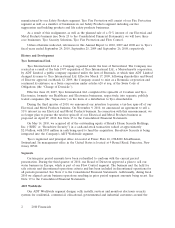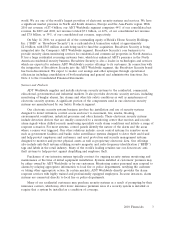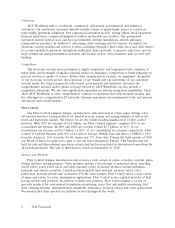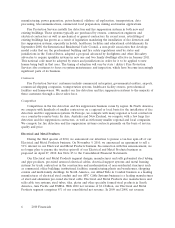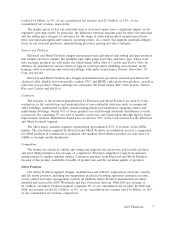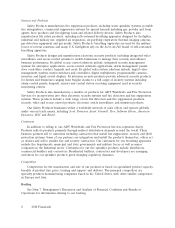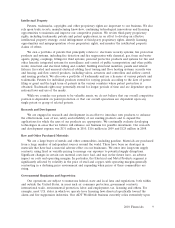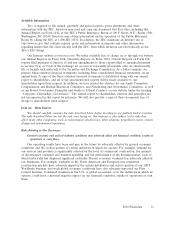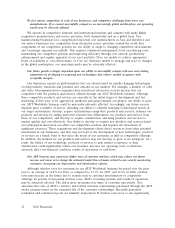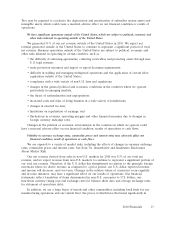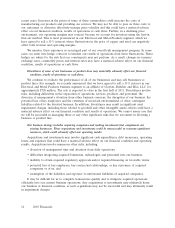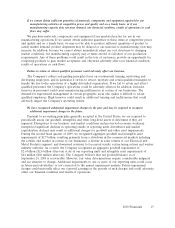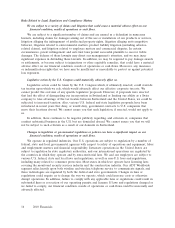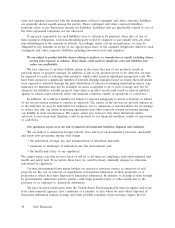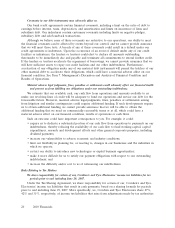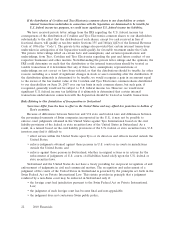ADT 2010 Annual Report Download - page 100
Download and view the complete annual report
Please find page 100 of the 2010 ADT annual report below. You can navigate through the pages in the report by either clicking on the pages listed below, or by using the keyword search tool below to find specific information within the annual report.We face intense competition in each of our businesses, and competitive challenges from lower cost
manufacturers. If we cannot successfully compete in an increasingly global market-place, our operating
results may be adversely affected.
We operate in competitive domestic and international markets and compete with many highly
competitive manufacturers and service providers, both domestically and on a global basis. Our
manufacturing businesses face competition from lower cost manufacturers in Asia and elsewhere and
our service businesses face competition from alternative service providers around the world. Key
components of our competitive position are our ability to adapt to changing competitive environments
and to manage expenses successfully. This requires continuous management focus on reducing costs,
maintaining our competitive position and improving efficiency through cost controls, productivity
enhancements and regular appraisal of our asset portfolio. If we are unable to achieve appropriate
levels of scalability or cost-effectiveness, or if we are otherwise unable to manage and react to changes
in the global marketplace, our operating results may be adversely affected.
Our future growth is largely dependent upon our ability to successfully compete with new and existing
competitors by developing or acquiring new technologies that achieve market acceptance with
acceptable margins.
Our businesses operate in global markets that are characterized by rapidly changing technologies,
evolving industry standards and potential new entrants in our markets. For example, a number of cable
and other telecommunications companies have introduced interactive security services that are
competitive with the products and services offered through our ADT Worldwide business. Although
these competitive products and services are currently in the initial stages of development and test
marketing, if they were to be aggressively marketed and gained market acceptance, our ability to grow
our ADT Worldwide business could be materially adversely affected. Accordingly, our future success
depends upon a number of factors, including our ability to: identify emerging technological trends in
our target end-markets; develop, acquire and maintain competitive products and services; enhance our
products and services by adding innovative features that differentiate our products and services from
those of our competitors; and develop or acquire, manufacture and bring products and services to
market quickly and cost-effectively. Our ability to develop or acquire new products and services based
on technological innovation can affect our competitive position and requires the investment of
significant resources. These acquisitions and development efforts divert resources from other potential
investments in our businesses, and they may not lead to the development of new technologies, products
or services on a timely basis or that meet the needs of our customers as fully as competitive offerings.
In addition, the markets for our products and services may not develop or grow as we anticipate. As a
result, the failure of our technology, products or services to gain market acceptance or their
obsolescence could significantly reduce our revenues, increase our operating costs or otherwise
adversely affect our financial condition, results of operations or cash flows.
Our ADT business may experience higher rates of customer attrition, which may reduce our future
revenue and cause us to change the estimated useful lives of assets related to our security monitoring
customers, increasing our depreciation and amortization expense.
Although attrition rates for customers in our ADT Worldwide business decreased over the prior
year to an average of 12.8% for 2010, as compared to 13.3% for 2009, and 12.9% in 2008, attrition
rates may increase in the future due to reasons such as customer dissatisfaction or competitive
offerings. In periods of increasing attrition rates, ADT’s recurring revenue and results of operations
may be adversely affected. The risk is more pronounced in times of economic uncertainty. Tyco
amortizes the costs of ADT’s contracts and related customer relationships purchased through the ADT
dealer program based on the estimated life of the customer relationships. Internally generated
residential and commercial pools are similarly depreciated. If attrition rates were to rise significantly,
12 2010 Financials


